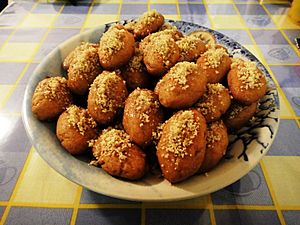Melomakarono facts for kids
 |
|
| Course | Dessert |
|---|---|
| Place of origin | Greece |
| Main ingredients | Semolina, olive oil and honey |
The melomakarono (plural: melomakarona) is a delicious Greek dessert. It is shaped like an egg and is mainly made from flour, olive oil, and honey.
Along with another cookie called kourabies, melomakarona are a traditional sweet treat. People usually make them during the Christmas holiday season. They are also sometimes called finikia.
What are Melomakarona?
Melomakarona are soft, sweet cookies. They are soaked in a special syrup after baking. This makes them very moist and full of flavor. They are a popular part of Greek Christmas celebrations.
A Sweet History
The history of melomakarona goes back a long time. They are thought to come from ancient and medieval "makaria." These were simple bread-like foods eaten during funerals. Over time, the recipe changed a lot. People started dipping them in honey. This led to the sweet treat we know today.
The name "melomakarono" comes from two Greek words. "Meli" means honey. "Makaria" refers to the old bread. So, the name means "honey makaria."
How They're Made
Making melomakarona involves a few steps. The main ingredients are flour or semolina, sugar, and orange zest. Sometimes fresh orange juice is added too. Other ingredients include cognac (a type of drink), cinnamon, and olive oil.
When the dough is rolled, people often fill the cookies with ground walnuts. After they are baked, the warm cookies are quickly dipped into a cold syrup. This syrup is made from honey and sugar mixed in water. This step makes the cookies sweet and juicy.
Finally, the melomakarona are decorated. They are usually topped with more ground walnuts. Sometimes bigger pieces of walnut are used too. A newer version of this traditional cookie is covered in dark chocolate.
See also
 In Spanish: Melomakarono para niños
In Spanish: Melomakarono para niños


